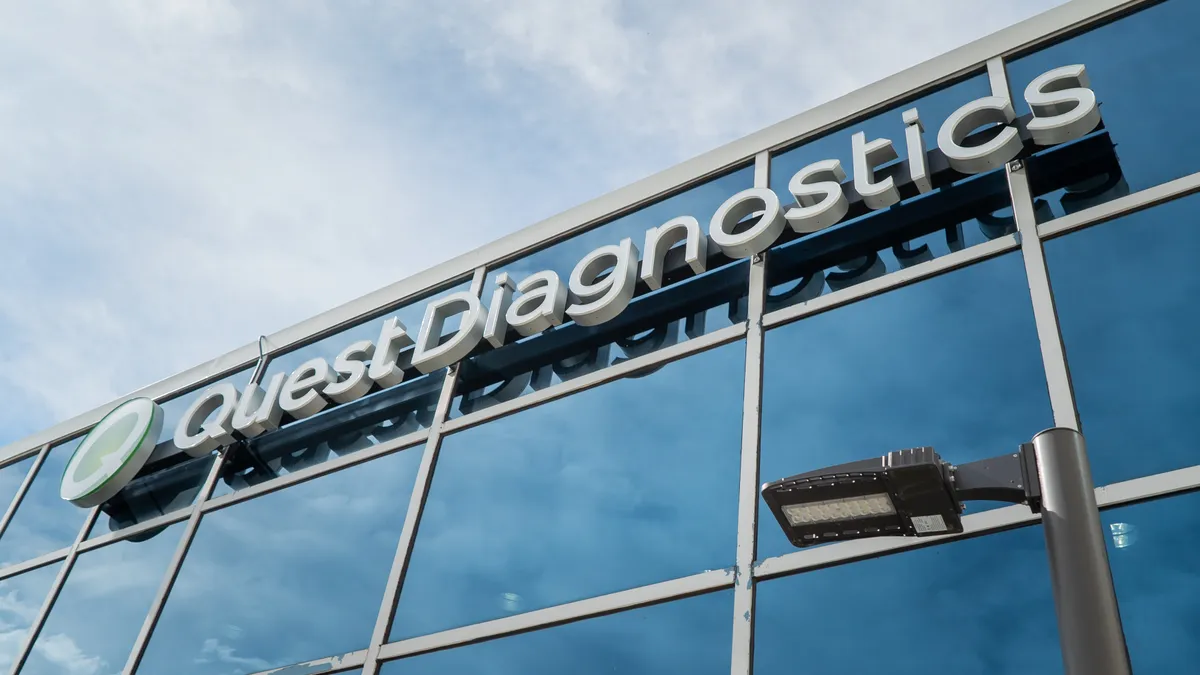Dive Brief:
- Quest Diagnostics on Thursday reported fourth-quarter revenue of $3 billion, an increase of 55.8% compared to the prior year, driven by strong demand for COVID-19 testing and offset by a single-digit decline in its base business.
- The lab network said that its 2020 base business recovery over the summer and fall stalled at the end of November and into December due to the surge in cases across the U.S. Given the uncertainty of the pandemic as vaccines are rolled out and new virus strains emerge, Quest on Thursday's investor call only provided an outlook for the first six months of 2021.
- While CEO Steve Rusckowski predicted a strong year for COVID-19 testing, Quest predicts demand will likely decline throughout 2021 as more people are vaccinated and fewer new coronavirus cases are reported.
Dive Insight:
The surge in COVID-19 infections across the country at the end of November and into December led to high demand for Quest's COVID-19 testing, but its non-coronavirus base business declined in the fourth quarter.
While CFO Mark Guinan reported on Thursday's investor call that the company's organic base volume trends "remained relatively steady" in January compared to December, he said Quest is only providing an outlook for the first six months of 2021.
Quest forecast first half revenue between $4.85 billion and $5.15 billion, up 33% to 41% versus 2020, according to Guinan. However, he emphasized that the "demand for, and duration of, COVID-19 testing as well as the continued recovery in the base business are significant swing factors that remain challenging forecasts."
Guinan said while Quest's outlook for the first six months of 2021 assumes "gradual improvement" in base testing volumes, the company foresees its base business remaining below 2019 pre-pandemic levels. When it comes to COVID-19 molecular diagnostic testing, Quest predicts average daily volumes to decline throughout the first half of the year as more people become vaccinated with volumes lower in the second quarter compared to the first quarter.
"If the country vaccinates a significant portion of the population by the summer, we would expect the continued decline in COVID-19 molecular testing volumes in the second half of 2021 compared to our expectations for the first half," Guinan added.
Quest supports the Biden administration's efforts to scale up the nation's testing capacity and expand the availability of test supplies as part of a national strategy to reduce the spread of COVID-19, according to Rusckowski.
Even amid a nationwide drop in daily coronavirus cases, Quest continues to add capacity and can currently perform about 225,000 COVID-19 molecular diagnostic tests and 200,000 serology tests per day.
Guinan on Thursday said at the end of the fourth quarter Quest averaged about 130,000 COVID-19 molecular tests and 10,000 serology tests per day, both well below the company's current daily testing capacity. Overall, Quest performed 12.5 million molecular and 1 million serology tests in the fourth quarter, contributing about 29% volume growth.
However, Guinan warned that COVID-19 molecular testing reimbursement will likely be lower this year.
A policy left over from the Trump administration that Quest is eyeing is a rule from CMS that would reduce payment to labs by 25% if they take longer than two days to return results for high throughput COVID-19 diagnostic tests. Guinan noted that several commercial payers have also moved to this new reimbursement model.
So far this year, Quest has been able to keep the average wait times for its molecular diagnostic testing to approximately 1-2 days. While Guinan said the company is "encouraged" by the fact that HHS now plans to extend the public health emergency throughout 2021, he warned that "changes to COVID molecular reimbursement are still possible" and could have a potential negative impact.
Nonetheless, Guinan said Quest's financial position "remains very strong" and that the company has increased its quarterly dividend by 10.7% with plans for future share repurchases. He also noted that Quest returned about $138 million in provider relief funds in the fourth quarter that the company previously received under the Coronavirus, Aid, Relief and Economic Security Act.












